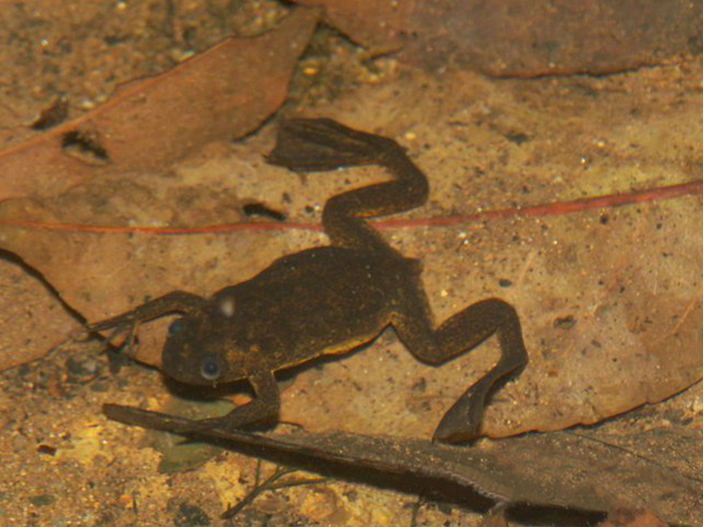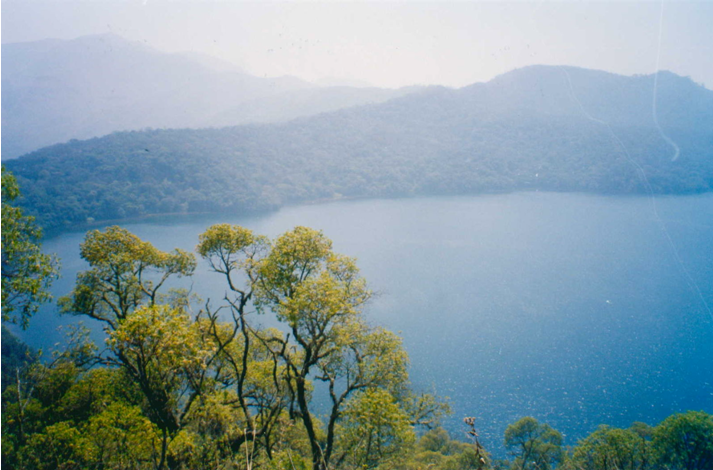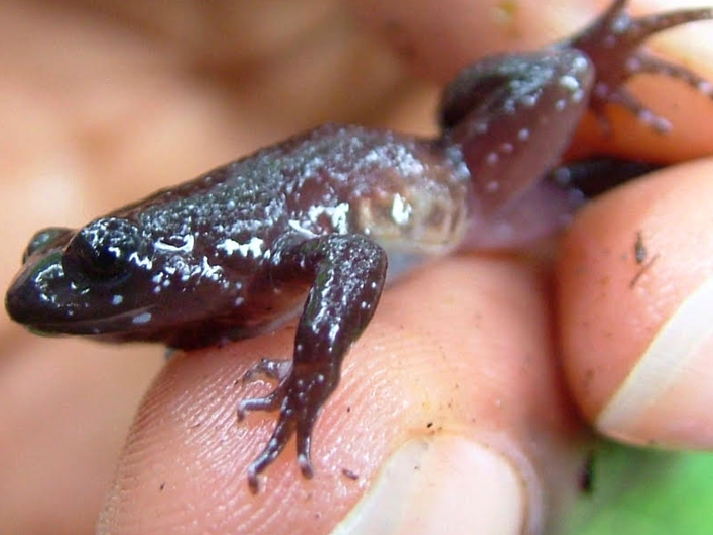- Survey work discovers at least 50 amphibian species living on Mount Oku, a dormant volcano in Cameroon.
- Mount Oku’s puddle frogs are vanishing – and no one knows why. Some species may already be extinct.
- Researchers say survey work is often overlooked for ‘sexier’ science, but this could hamper saving species.
Amphibians around the world are in a state of crisis. Over 40 percent are threatened with extinction. Chytrid fungus, a disease fatal to most amphibians, is decimating populations already threatened by human impacts like climate change, pesticides, and deforestation. Before conservationists can develop action plans to protect amphibians, however, they need to know which species are where. That’s where species surveys come in.
Last month, a pair of researchers, Thomas Doherty-Bone and Václav Gvoždík, published an updated list of amphibian species found on Mount Oku in Cameroon. The new list is a result of over a decade of work, and provides vital information about one of the most unique mountains in Cameroon: Mount Oku, a dormant volcano boasting high numbers of rare and endemic species.
Doherty-Bone and Gvoždík doubled the size of Mount Oku’s old amphibian inventory, adding 25 new species. In addition, they discovered one species of puddle frog potentially new to science. If confirmed, it would mean 51 amphibians inhabit the mountain.
Troublingly, the scientists also found that nearly half of the species on the mountain are likely threatened with extinction. The researchers consider forest degradation to be the main culprit, but puddle frogs (the genus Phrynobatrachus), are currently declining at especially alarming rates.
David Blackburn, a University of Florida herpetologist with a long research history in Cameroon, has seen this first-hand.
“These were species that were literally… everywhere,” he said of puddle frogs. “You could stand at the edge of Lake Oku during the day and see [puddle frogs] just jumping off the leaves… now we could have six to eight of us looking at the same time, and even despite that, we still can’t find them.”
Unfortunately, the survey work needed to track these declines is often overlooked. There is “a lack of incentive for researchers to publish their lists as this is not ‘sexy’ science,” said coauthor Thomas Doherty-Bone with the Royal Zoological Society of Scotland. “The bread and butter of a scientist is to publish a high quality paper testing a hypothesis, and species inventories (the baseline of ecology) are unfortunately not going to get anyone a promotion.”
Sexy or not, up-to-date species inventories can mean life or death for amphibian populations. When asked what the biggest challenge of surveying amphibians is, Doherty-Bone replied, “seeing them before they disappear.”
The story of Mount Oku illustrates why the often thankless work of surveying amphibian populations is critically important – now more than ever.
Mount Oku: a volcano turned biodiversity hotspot
At over 3,000 meters, Mount Oku is the second-tallest mountain in what is known as the Cameroon line, a chain of volcanoes that begins as a string of islands in the Gulf of Guinea and continues inland along the border of Cameroon and Nigeria.
Oku itself is situated in the Western High Plateau, an inland region of the chain that is of particular interest to researchers. This is because many of the dormant volcanoes host unique species, which are kept separated from their relatives in pockets of high-elevation rainforest. Within the past 15 years, however, Mount Oku has begun to receive special attention even within this volcanic group.
“Early on, this was driven by Birdlife International trying to conserve forest birds that are found only on Mount Oku,” said Blackburn. “But as we’ve had more work by amphibian biologists on Mount Oku, there’s been new species discovered and described… including quite a number of frogs that are found only on Mount Oku or very near to only on Mount Oku.”
In fact, of the 50 amphibian species currently thought to inhabit Mount Oku, five – six if the newly described Phrynobatrachus is indeed a new species – amphibians are endemic, and seven are endemic to the Western Highland Plateau.
Mount Oku is unique, in part, because it has something that many other mountains do not: a crater lake. One frog species, the Lake Oku clawed frog (Xenopus longipes) is found only in that crater lake, and another, the Lake Oku puddle frog (Phrynobatrachus njiomock) is found only in the forest around the lake. Add to this the rainforest, the high summit, and grasslands at the peak, and Mount Oku emerges as a “really unique site even within Cameroon” with a large host of endemic species, explained Blackburn.

Figuring out just how many species are truly endemic can be trickier than one might expect, however. Researchers believe that in colder times, mountains in the region were more closely ecologically linked than they are today. This raises a number of questions about species relatedness and diversity in Mount Oku and surrounding mountains. The answer to these questions is necessary in order to build conservation plans that protect not just species, but the environmental processes that enable them to thrive.
However, the time to build these plans is running out.

Expensive, thankless work: the challenges of conducting surveys
Without scientists like Doherty-Burn and Gvoždík publishing up-to-date inventories, phenomena like Mount Oku’s rapidly disappearing puddle frogs could go unnoticed until it is too late. For endemic species like the Mount Oku puddle frog, that means extinction.
“As conservationists work to identify key biodiversity areas, good surveys are essential in helping us understand where best to allocate limited conservation resources,” said Anne Baker, executive director of the amphibian conservation organization Amphibian Ark.
The lack of incentive to publish such surveys is damaging, as survey work comes with many challenges. Scientists need funding to buy equipment and support to spend time working in the field. The updated inventory of Mount Oku is the result of ten years of visual samples, acoustic surveys, pitfall traps, dip-netting, and funnel traps. It also depends on a great deal of local help, both from the communities and from individuals who have been trained to conduct field work.
Mount Oku’s high altitude and diverse habitats, including rainforest, grassland, and agriculture, make it a challenge to survey exhaustively. However, it is actually one of the easier mountains in the region to survey due to highly developed roads and a local economy dependent on ecotourism and white honey. In addition, the local leader, known here as the Fon, has helped facilitate biodiversity research on the mountain, and is so committed to ecotourism that the tourist office is located in his palace.
From knowledge to action: racing the clock
Through cumulative efforts, Doherty-Bone and Gvoždík have added 25 names to the list on Mount Oku. Some of these, such as hairy frogs (Trichobatrachus robustus), were unsurprising. Doherty-Bone described others as more unexpected, like the rocket frog (Ptychadena taeniocelis) and the egg frog (Leptodactylon axillaris), both of whose ranges were thought to stop farther south.

Another, the Schiotz’s puddle frog (Phrynobatrachus schioetzi), had never before been recorded in Cameroon. Given the dire situation for puddle frogs on Mount Oku, its addition to the list is bittersweet. A species disappearing even as it is added onto an inventory is disheartening, but not an uncommon story for amphibians worldwide.
“What [concerns me] is how many species we will lose without ever knowing that they even existed,” Baker said.
Now that the researchers have named names, it is up to conservationists to try to find solutions to the threats facing nearly half of Mount Oku’s amphibians.
“It might already be too late for some species, such as the puddle frogs, but conservation of the natural habitats on Mount Oku needs to continue and to improve,” says Doherty-Bone.
The amphibians on the mountain are threatened by a cocktail of dangers, including deforestation, climate change, pesticide use, and over-exploitation. There has also been an increase in chytrid fungus on the mountain in recent years, but “that pathogen has been in Cameroon since 1934,” said Doherty-Bone.
The next step is to try to gain a better genetic understanding of frogs in the area, and to expand the inventory by adding museum specimens collected on the mountain to the list. Researchers also need to uncover why puddle frogs are declining while other amphibian populations remain stable.
For those most at-risk, says Doherty-Bone, captivity should be considered as an option. A step that has already created an insurance policy for the Lake Oku clawed frog.
Conducting surveys might not be “sexy science,” but with amphibians disappearing faster than they can be discovered and documented, it is essential, often unsung, work. Let’s hope the Mount Oku survey has been published in time to save its critically endangered species.
Citation:
Doherty-Bone, T. M., & Gvoždík, V. (2017). The Amphibians of Mount Oku, Cameroon: an updated species inventory and conservation review. ZooKeys. 643: 19-139
NOTE (10 March 2017): A previous version of this article miscaptioned the third picture as a hairy frog. The frog in the image is an egg frog. We regret the error, which has now been corrected.